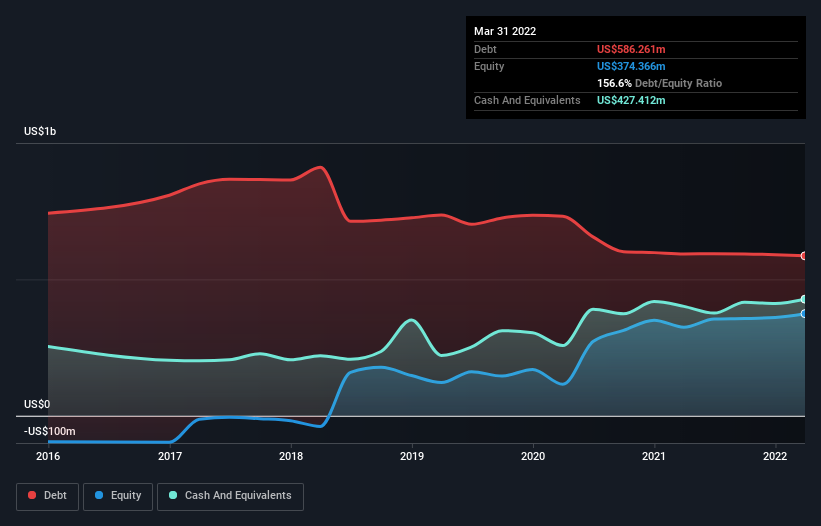
Some say volatility, rather than debt, is the best way to think about risk as an investor, but Warren Buffett famously said that 'Volatility is far from synonymous with risk.' It's only natural to consider a company's balance sheet when you examine how risky it is, since debt is often involved when a business collapses. As with many other companies EVO Payments, Inc. (NASDAQ:EVOP) makes use of debt. But the real question is whether this debt is making the company risky.
When Is Debt Dangerous?
Debt assists a business until the business has trouble paying it off, either with new capital or with free cash flow. If things get really bad, the lenders can take control of the business. However, a more common (but still painful) scenario is that it has to raise new equity capital at a low price, thus permanently diluting shareholders. Of course, the upside of debt is that it often represents cheap capital, especially when it replaces dilution in a company with the ability to reinvest at high rates of return. When we think about a company's use of debt, we first look at cash and debt together.
See our latest analysis for EVO Payments
How Much Debt Does EVO Payments Carry?
As you can see below, EVO Payments had US$586.3m of debt, at March 2022, which is about the same as the year before. You can click the chart for greater detail. On the flip side, it has US$427.4m in cash leading to net debt of about US$158.8m.

A Look At EVO Payments' Liabilities
According to the last reported balance sheet, EVO Payments had liabilities of US$622.3m due within 12 months, and liabilities of US$809.4m due beyond 12 months. Offsetting this, it had US$427.4m in cash and US$36.1m in receivables that were due within 12 months. So its liabilities total US$968.1m more than the combination of its cash and short-term receivables.
This deficit isn't so bad because EVO Payments is worth US$1.87b, and thus could probably raise enough capital to shore up its balance sheet, if the need arose. But we definitely want to keep our eyes open to indications that its debt is bringing too much risk.
We use two main ratios to inform us about debt levels relative to earnings. The first is net debt divided by earnings before interest, tax, depreciation, and amortization (EBITDA), while the second is how many times its earnings before interest and tax (EBIT) covers its interest expense (or its interest cover, for short). Thus we consider debt relative to earnings both with and without depreciation and amortization expenses.
While EVO Payments's low debt to EBITDA ratio of 1.0 suggests only modest use of debt, the fact that EBIT only covered the interest expense by 3.3 times last year does give us pause. So we'd recommend keeping a close eye on the impact financing costs are having on the business. Notably, EVO Payments's EBIT launched higher than Elon Musk, gaining a whopping 139% on last year. There's no doubt that we learn most about debt from the balance sheet. But it is future earnings, more than anything, that will determine EVO Payments's ability to maintain a healthy balance sheet going forward. So if you want to see what the professionals think, you might find this free report on analyst profit forecasts to be interesting.
Finally, while the tax-man may adore accounting profits, lenders only accept cold hard cash. So it's worth checking how much of that EBIT is backed by free cash flow. Over the last three years, EVO Payments actually produced more free cash flow than EBIT. That sort of strong cash generation warms our hearts like a puppy in a bumblebee suit.
Our View
Happily, EVO Payments's impressive conversion of EBIT to free cash flow implies it has the upper hand on its debt. But truth be told we feel its interest cover does undermine this impression a bit. Taking all this data into account, it seems to us that EVO Payments takes a pretty sensible approach to debt. While that brings some risk, it can also enhance returns for shareholders. There's no doubt that we learn most about debt from the balance sheet. But ultimately, every company can contain risks that exist outside of the balance sheet. Case in point: We've spotted 1 warning sign for EVO Payments you should be aware of.
If you're interested in investing in businesses that can grow profits without the burden of debt, then check out this free list of growing businesses that have net cash on the balance sheet.
Valuation is complex, but we're here to simplify it.
Discover if EVO Payments might be undervalued or overvalued with our detailed analysis, featuring fair value estimates, potential risks, dividends, insider trades, and its financial condition.
Access Free AnalysisHave feedback on this article? Concerned about the content? Get in touch with us directly. Alternatively, email editorial-team (at) simplywallst.com.
This article by Simply Wall St is general in nature. We provide commentary based on historical data and analyst forecasts only using an unbiased methodology and our articles are not intended to be financial advice. It does not constitute a recommendation to buy or sell any stock, and does not take account of your objectives, or your financial situation. We aim to bring you long-term focused analysis driven by fundamental data. Note that our analysis may not factor in the latest price-sensitive company announcements or qualitative material. Simply Wall St has no position in any stocks mentioned.
About NasdaqGM:EVOP
EVO Payments
EVO Payments, Inc. operates as an integrated merchant acquirer and payment processor worldwide.
Excellent balance sheet and good value.
Similar Companies
Market Insights
Community Narratives





